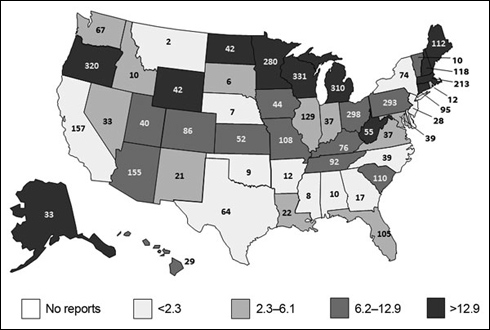Norovirus leading cause of AGE
Click Here to Manage Email Alerts
Norovirus is emerging as a leading cause of acute gastroenteritis in the United States, according to recently published data.
Aron J. Hall, DVM, MSPH, an epidemiologist with the viral gastroenteritis team in the division of viral diseases of the National Center for Immunization and Respiratory Diseases, CDC, and colleagues recently published data from the National Outbreak Reporting System (NORS). This system is an expanded analysis of the Foodborne Disease Outbreaks Surveillance System and the Waterborne Disease and Outbreak Surveillance System that launched 4 years ago. Until 2009, national surveillance for acute gastroenteritis (AGE) outbreaks in the United States had been limited to foodborne or waterborne disease outbreaks because a system did not exist for AGE outbreaks spread by other transmission modes.

Aron J. Hall
The researchers analyzed 2 years of data, including 4,376 reported AGE outbreaks, which resulted in 122,488 reported illnesses, 2,952 hospitalizations and 168 deaths. They found that norovirus was the leading cause of AGE outbreaks.
“Although norovirus usually causes self-limiting disease, it can cause severe outcomes when outbreaks occur among vulnerable populations, such as nursing home residents,” the researchers wrote.
The next most frequent contributors to AGE outbreaks were Salmonella, Shigella, and a toxin-producing type of Escherichia coli. Most AGE outbreaks resulted from person-to-person transmission and occurred most frequently in health care facilities.

Figure 1. Total number and annual rate of reported acute gastroenteritis outbreaks per 1 million population by reporting state, National Outbreak Reporting System, United States, 2009–2010. The number given in each state indicates the total number of outbreaks over the 2-year study period; the shading denoted by the legend indicates the reporting rate by quartiles. Multistate outbreaks (n=48) and those reported by Puerto Rico (n=15) and the District of Columbia (n=24) are not shown.
Source: CDC
“Expanded surveillance through NORS provides a more complete characterization of AGE outbreaks, which can inform prevention efforts,” Hall told Infectious Disease News.
Hall and colleagues said their research highlights the importance of emphasizing good infection control practices to clinicians and patients.
“Norovirus control through hand hygiene, environmental disinfection, and isolation of ill persons should remain a priority and likely affords protection against other AGE agents,” the researchers concluded.
Disclosure: Hall reports no relevant financial disclosures.
